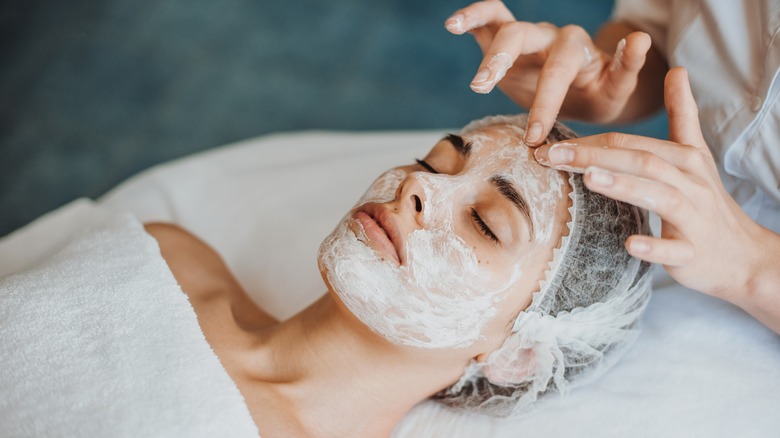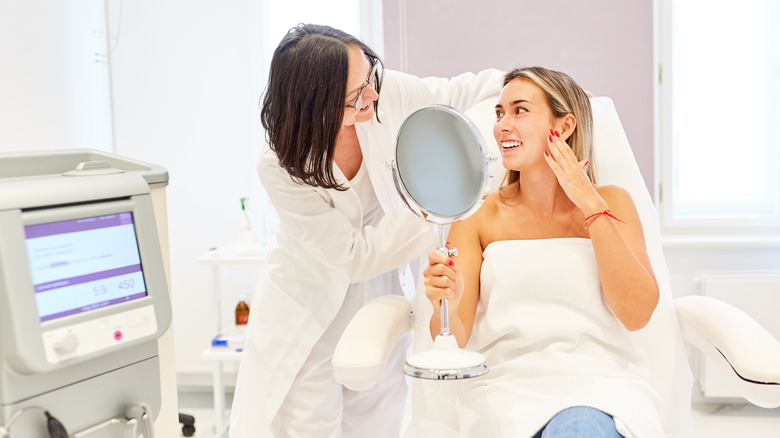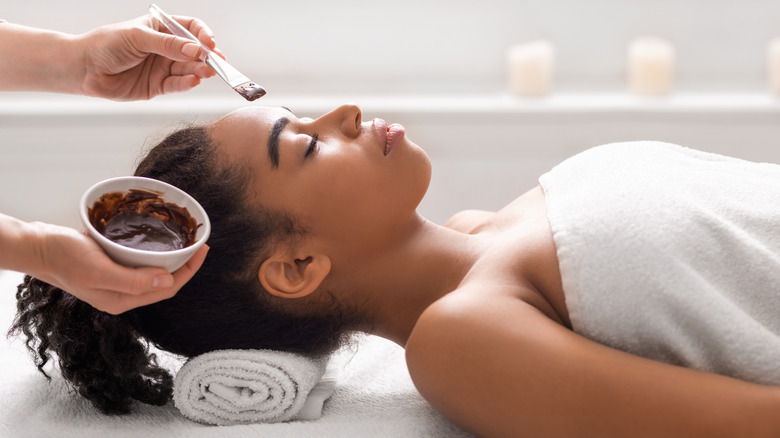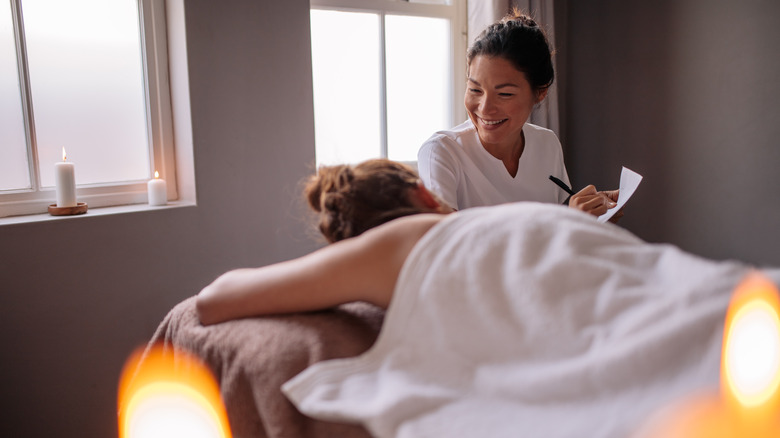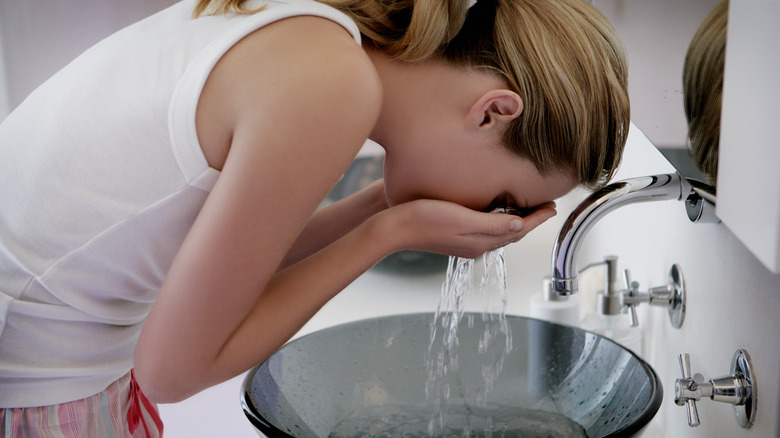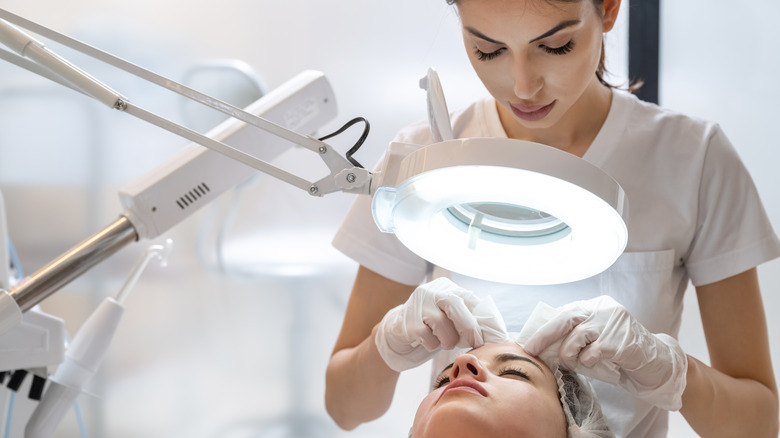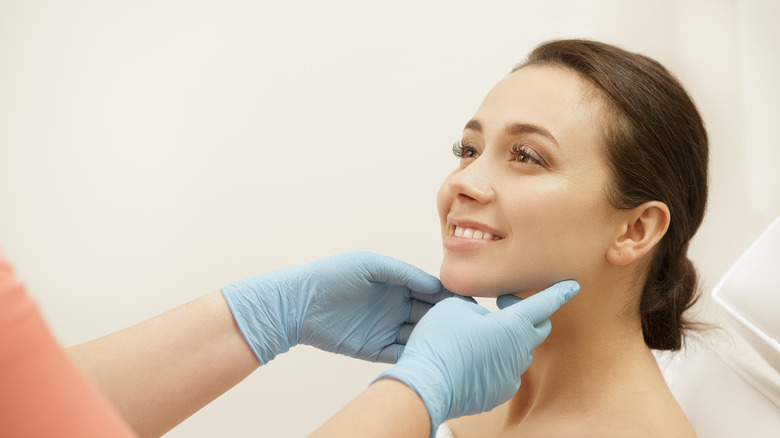Our Guide To Getting Facials If You Have Sensitive Skin
Getting a facial is a great way to pamper yourself. While it's an ultimate act of self-care, it's also a downright necessity for some people. Treating your skin every now and then to something more involved than your everyday routine can be the game-changer your complexion needs. That's true whether you're combatting the visible signs of aging or dealing with blemishes.
What happens when your skin is sensitive, though? If you fall into this category, you're probably well aware of the pitfalls associated with taking skincare risks. You know how it goes: Something catches your eye at the store, so you grab it thinking it may work — only to suffer the ramifications of your experiment in the aftermath.
There are many signs that you may have sensitive skin, from redness to itchiness to full-blown irritation that makes you want to hide. You might find you need to revise your routine, relying strictly on the tried-and-true ingredients that you know work well for you. While it can be a bummer to deal with this, it doesn't mean kissing the chance for a facial goodbye. You absolutely can take advantage of this beneficial treatment — provided you keep these precautionary measures in mind.
Look for the right ingredients
If you've had sensitive skin for as long as you can remember, you probably have a few trusted ingredients that always treat your skin right. It's smart for anyone who has sensitivities to identify ingredients in facials that can soothe and provide gentle nourishment.
Among the most comforting is oat extract, commonly found in sensitive skin formulas for the face and body. According to EarthHero, Oatmeal is a natural anti-inflammatory that can calm angry skin and alleviate common issues associated with sensitivity, such as redness and irritation. Chamomile is also an excellent choice for treating sensitive skin, especially "those who have acne or are prone to breakouts" because of its skin-soothing anti-inflammatory properties.
Some facials formulated for sensitivity have potent emollients that quench your skin's thirst and leave it softer. Those include hyaluronic acid, which locks in moisture, oils like argan, squalane, meadowfoam, and jojoba to wrap your skin in a comforting and softening cocoon, and calendula to ease distress and leave skin calm. The right ingredients can make all the difference in how your skin feels post-treatment.
Get a professional skin analysis
You might know that your skin is sensitive because of how it responds when you use certain ingredients or even eat certain foods — but do you know what's happening on a deeper level? Not everyone does, so you might consider undergoing a professional skin analysis to learn more about what's truly going on underneath the surface.
There are different types of analyses available. Some providers offer "mapping" techniques that involve performing a comprehensive and intuitive examination of your face, from skin tone to hydration levels, to determine your actual skin type and what could be responsible for your discomfort. Some medical spas offer three-dimensional analyses that inspect your pores, assess sun damage levels, visible signs of aging, and more.
The analysis can help you glean a greater understanding of your skin's needs, helping you make smarter choices moving forward — not just when it comes to spa treatments like facials but also the products you use on a daily basis.
Talk to your dermatologist
Nothing can replace a professional opinion if you're concerned about your skin's behavior. Whether the irritation is too uncomfortable to handle, you're tired of spending money on products that don't work, or you want to tackle the redness for good, a dermatologist can help you find some answers.
"With skin inflammation, the immune system is essentially overreacting to an irritant or allergen that the skin is exposed to," Board-certified dermatologist Dr. Ming Jih tells Houston Methodist. "Some people are naturally born with sensitive skin, but anyone can experience sensitive skin if their skin is exposed to irritants or allergens that triggers inflammation."
Your doctor can often pinpoint a root cause by going over the products that you normally use, from your laundry detergent to your moisturizer. Jih also notes that sometimes sensitive skin is a symptom of another health condition, so it's doubly important to seek medical attention to rule out potential other causes that might be at play.
Ask your esthetician the right questions
Avoid delving into a facial before asking your esthetician a few key questions. While all professionals require experience, some may be more skilled at treating sensitive skin than others. It's worth asking your provider about their background in this area before you book your appointment.
Most experienced facialists will perform a comprehensive examination of your skin as the first step of the treatment. They may even take your medical history to better understand any skin conditions you need to look out for, such as rosacea, eczema, or psoriasis. Ask them whether they have ingredients that are suitable for skin like yours, and find out what you can expect.
Some professionals may embark on a mission to sell you their products, but you can ask them for a general idea of the types of items you should use on your skin after the facial to keep it smooth and prevent irritation. For example, they might suggest cleansing with a milky emulsion or using a cream free of fragrances, parabens, and dyes to lock in moisture and minimize redness. Take note of who provides you with clear, forthright answers — this is someone you'll want to visit again if you enjoyed the facial.
Know the difference between sensitive and reactive skin
Sensitive, reactive — potato, potahto, right? Not quite. First, a little behind the name: It turns out that "reactive" was really a term developed by estheticians in reference to skin that reddens or develops irritation upon exposure to certain types of ingredients or products.
Meanwhile, sensitive skin is "attributable to genetics" and may lead to symptoms like hives or swelling, per Skin Inc. Your skin may also burn or sting if it is sensitive to something that stimulates your nerves, like a topical cream or the touch of a rough fabric or a change in temperature.
So, many people who believe they have sensitive skin are actually reacting to certain ingredients — and because they might use those ingredients on a regular basis, they may not even realize that those products are doing more harm than good. While a good esthetician can usually tell the difference, a dermatologist can help you determine which is more likely your area of concern.
Get the lowdown on your facial treatment
It turns out that the average treatment steps may not apply to you if your skin is sensitive — which is why it's so important to have a good conversation with your esthetician before you get started about what to expect when getting a facial. Ask them to explain every step of the facial, from the initial analysis to the final product they apply.
You should know what they are using during each step, too. Don't be afraid to delve deeper here. If they begin with a cleansing product, ask what's in the cleanser beforehand. If they're applying a mask, make sure that it's suitable for your skin, with ingredients that soothe and hydrate so your skin feels its best after the treatment.
Find out about the targeted ingredients that they plan to use, too. The best facials are tailored to your skin's unique needs, which is where these specific ingredients come into play. Some can tackle redness effectively, others soothe irritation, and others can reduce inflammation. Your facialist will create the perfect skin "cocktail" to ensure you leave the spa with healthy skin that feels and looks its best.
Share your concerns with the esthetician
Your esthetician is kind of like your skin's therapist, there to address its needs and help it be the best possible version of itself that it can be. To do that, they'll need a little guidance on your part. "Your facialist should be taking the lead in assessing your skin's needs, but it's always a good idea to bring in a list of what you're currently using for skincare, as well as a list of the skin concerns you'd like to address," celebrity esthetician Candace Marino explains to Real Simple.
They can get a great idea of your skin's general condition by the types of items you use and the areas that bother you the most, whether it's the red skin around your nose or the general tightness you feel after cleansing. Even with five-star communication before treatment begins, however, no one can truly predict how your skin will respond — which is why you shouldn't be shy to speak up if necessary.
Let's say your skin begins to itch or burn while your esthetician is applying a face mask. This is the moment that so many in the chair dread because it means speaking up and potentially having an uncomfortable conversation. Good news: Your esthetician would much rather know that than have you hold back. Dermatologist Amy Wechsler explained to Vogue India, "You could say something like, 'I'm feeling uncomfortable and would really like you to look at my skin to make sure it's alright ...'".
Identify your primary facial goals
No two facial treatments are alike. While most spa menus have a few à la carte options that consist of a series of steps using the same ingredients each time, they also have the option to provide a custom facial. That's precisely what you need if your skin is sensitive — even if they have a sensitive skin facial on the menu.
That's because, again, your sensitive skin may differ from the sensitive skin of another person. You may not respond well to a certain ingredient. Taking the custom route allows your esthetician to address your primary goals, whether you want to minimize redness, alleviate tightness, concentrate on sun damage, or address fine lines and other visible signs of aging without fear of experiencing harsh side effects.
A skilled esthetician can handle all of these requests and will consider everything from your history to the current condition of your skin to determine the right medley of products to use during your appointment. You're far more likely to experience a positive outcome when your facial is made just for your skin.
Seek out the best of the best
Never underestimate the importance of seeking out the best person for the job. At a bare minimum, your facialist should be licensed and certified. You'll have confidence knowing they've undergone training and have the education to back it up.
You can glean a lot about your facialist just from talking to them, too. The best candidates will ask you plenty of questions about your skin, take notes, perform a thorough analysis, and do their utmost to get to the root of what you expect from the facial. They'll also encourage you to speak up and let them know if you feel any discomfort. Take a good look at your surroundings, too. A spa with top estheticians is usually pristine, with strict attention to safety protocols.
Finally, look into things the old-fashioned way — by digging up some reviews online and asking around. Word of mouth counts for a lot, especially if you have a trusted friend who knows a thing or two about beauty and who has sensitive skin, too. You can even ask your dermatologist for recommendations, as they may have heard from their patients about qualified people who offer top-notch facials for sensitivity.
Prepare your skin to minimize sensitivity
There are a few things that you can do in advance of your facial to get your skin as ready as it can possibly be for the treatment. While it's often advised to skip your usual routine if you're headed straight to the spa first thing in the morning, that might not be wise when you have sensitive skin. If your skin typically feels tight and itchy if you don't at least cleanse and moisturize it, make sure to do those things.
However, avoid anything that might stimulate your skin. That includes exfoliating agents, blackhead cleansing strips, or anti-aging products containing ingredients like retinol and peptides. Even if your skin can tolerate these ingredients, you should avoid using them prior to your facial so you don't risk any potential for a reaction.
Keep in mind that you can't predict what your skin will look like after a facial, but if your esthetician uses the right products, it should, at the very least, feel comforted. At the same time, there's a chance that you might break out or experience another type of reaction after your treatment. That's entirely normal — even people without sensitive skin may experience this. So while you may want to prep your skin for a big event, you should avoid planning your facial right before so your complexion has time to recover.
Pace your skin by scheduling infrequently
You might be tempted to go all in if your first facial is a resounding success. On the one hand, that's awesome, and you should definitely stick to them if you loved the experience and think it was good for your skin. On the other hand, you don't want to overdo it either.
A big reason for this is that your skin needs time to respond to the treatment. Remember that it's entirely possible for your skin to break out or develop some type of reaction to an ingredient used during the facial, but that might not happen right away. In the same way that you might not develop a blemish immediately after using a new skin cream, you could experience a delayed effect from the facial.
As a general rule of thumb, a monthly routine is best. Esthetician Joanna Vargas says to Allure, "I always recommend [that] clients have facials once a month, [because] nothing you do at home can replace professional attention." At the same time, you know your sensitive skin best. If you'd rather stretch it out to once every two months, you absolutely should — and if you know you'd like to work your way up to getting more regular facials, spacing them out like this is a good way to pace your skin.
Request to skip certain steps if necessary
If it's in the description of the service, then it must be mandatory, right? Um, no — definitely not, but especially not when your skin is sensitive. A good facialist will have this down already and may choose to omit certain steps based on what they assess about your skin during the initial analysis.
However, you should be clear about what will happen during the facial beforehand. If you never exfoliate your skin because sloughing away dead skin cells tends to leave it really uncomfortable, let them know immediately. They will likely offer a suitable alternative, like an extra-gentle mechanical exfoliant enriched with soothing oils to prevent irritation, but what you opt for is entirely up to you and your comfort levels.
The same goes for extractions, which are generally not advisable for people who have sensitive skin. During this portion of the facial, the esthetician removes blackheads and whiteheads with an extraction tool to clear your pores. Because it can be uncomfortable even for people who don't have sensitivities, it's best to avoid the step unless you know that your skin will respond well.
Take before and after pictures
Taking a few before-and-after photos is a great way to determine how well the facial treated your skin. This is helpful because you can clearly identify areas of concern before you went in for the treatment and see how those areas look after. For best results, take your "before" shots the night prior to — and right before — your facial. The first shot will give you an idea of your skin's appearance and condition as it normally is, and the second will depict changes, if any, that might have occurred overnight (like a blemish or redness).
You can show these pictures to your facialist, too. In addition to the information that you provide them, the photographs can serve as a guide that helps them better understand your skin and identify areas that might need a little more (or a little less) attention. Snap some photos after the facial, too, including one the day of and another the day after.
To your benefit, before-and-after pictures can also give you a general idea of how your skin has progressed through your facial journey. Does it look any better? Does it seem more irritated? Less red? Brighter? Clearer? You can make many different evaluations based on your photographs, which can help inform the types of facial treatments you undergo in the future, too.
Listen to your skin's needs
Maybe you went in for a facial and weren't pleased with the results. Perhaps your skin got all fired up and took a while to relax. Maybe you're still dealing with the effects of the treatment. While it can be distressing, keep in mind that all of this is common when you're dealing with issues like sensitive and reactive skin. Just like you can't always use a product on the shelf, you can't always count on a facial to treat your skin how you expect, either.
In these cases, it's typically best to see a dermatologist and get to the heart of the matter. It's possible that you have a skin condition that is best treated with prescription medication, which will help your skin look and feel so much better. You might eventually get to a point where getting a facial is comfortable, but it's always best to defer to your dermatologist for guidance. Your skin will thank you in the end.
